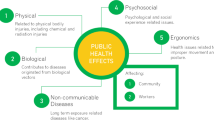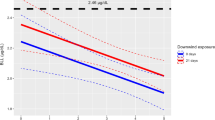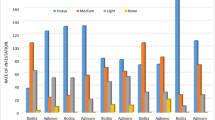Abstract
Objectives
The use of leaded petrol was prohibited in the Delhi city by the end of 1998. To determine the impact of use of unleaded petrol, this cross-sectional study was conducted to determine blood lead levels in primary school children.
Methods
Blood lead levels were estimated in 300 school children aged 6 to 10 y. The data regarding clinical features and putative risk factors for high blood lead levels was also collected.
Results
Of the 300 children, 36 (12 %) had high blood lead levels. Of the 36 children, 32 had blood lead levels between 10 and 19 μg/dl, 4 had 20–44 μg/dl and none had levels >45 μg/dl. Factors such as exposure to peeling paint, recent renovation of housing and near-distance of house to main road were significantly associated with high blood lead levels.
Conclusions
There is significant prevalence of high blood lead levels in school children in Delhi, even after with prohibition of use of leaded petrol.
Similar content being viewed by others
References
Tong S, Von Schirnding YE, Prapamontol T. Environmental lead exposure: A public health problem of global dimensions. Bull World Health Organ. 2000;78:1068–77.
Wilson N, Horrocks J. Lessons from the removal of lead from gasoline for controlling other environmental pollutants: A case study from New Zealand. Environ Health. 2008;7:1.
Centers for Disease Control and Prevention. Preventing lead poisoning in young children. Atlanta: CDC; 2005.
Koller K, Brown T, Spurgeon A, Levy L. Recent developments in low-level lead exposure and intellectual impairment in children. Environ Health Perspect. 2004;112:987–94.
Lead and its Health Effects [Internet]. Available from: http://cpcbenvis.nic.in/newsletter/airpollution-sep2001/sept2001air6.htm. Accessed on 6 Feb, 2013.
The George Foundation Report- project lead-free: a study of lead poisoning in major Indian cities. Proceedings of the International Conference on lead poisoning prevention and treatment, February 8–10, 1999. Bangalore: The George Foundation; 1999. pp. 79–85.
Demaeyer EM. Preventing and Controlling Iron Deficiency Anemia Through Primary Health Care. Geneva: World Health Organization; 1989.
Wright JP, Dietrich KN, Ris MD, et al. The association of prenatal and childhood blood lead concentrations with criminal arrests in early adulthood. PLoS Med. 2008;5:732–40.
Needleman HL, McFarland C, Ness RB, Fienberg SE, Tobin MJ. Bone lead levels in adjudicated delinquents a case control study. Neurotoxicol Teratol. 2002;24:711–7.
Jain NB, Laden F, Guller U, Shankar A, Kazani S, Garshick E. Relation between blood lead levels and childhood anemia in India. Am J Epidemiol. 2005;161:968–73.
Kalra V, Chitralekha KT, Dua T, Pandey RM, Gupta Y. Blood lead levels and risk factors for lead toxicity in children from schools and an urban slum in Delhi. J Trop Pediatr. 2003;49:121–3.
Kumar A, Scott Clark C. Lead loadings in household dust in Delhi. India Indoor Air. 2009;19:414–20.
Clark CS, Thuppil V, Clark R, et al. Lead in paint and soil in Karnataka and Gujarat, India. J Occup Environ Hyg. 2005;2:38–44.
Mahmood ZA, Zoha SM, Usmanghani K, et al. Kohl (surma): Retrospect and prospect. Pak J Pharm Sci. 2009;22:107–22.
Conflict of Interest
None.
Role of Funding Source
Ministry of Environment & Forest funded this study.
Author information
Authors and Affiliations
Corresponding author
Rights and permissions
About this article
Cite this article
Kalra, V., Sahu, J.K., Bedi, P. et al. Blood Lead Levels among School Children after Phasing-Out of Leaded Petrol in Delhi, India. Indian J Pediatr 80, 636–640 (2013). https://doi.org/10.1007/s12098-013-0999-6
Received:
Accepted:
Published:
Issue Date:
DOI: https://doi.org/10.1007/s12098-013-0999-6




